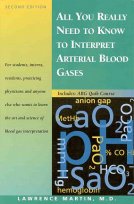1. Normal range for PaCO2 is 35-45 mm Hg. A sudden change in
PaCO2 from normal to 28 mm Hg means the subject
a) is hyperventilating.
b) has excess alveolar ventilation for the amount of CO2
production.
c) must be breathing faster than normal.
d) must have acute respiratory alkalosis.
e) has reached a new steady state for gas exchange.
2. Which of the following statements about PaCO2 (arterial PCO2)
is(are) true?
a) PaCO2 is directly related to the rate of CO2 production, and
inversely related to alveolar ventilation.
b) If PaCO2 goes up, while the inspired air remains unchanged
as to pressure and oxygen percentage, PaO2 will go down.
c) Even when PaCO2 is above 120 mm Hg, it is possible to
maintain a normal arterial oxygen saturation with inhaled
supplemental oxygen.
d) In patients with lung disease, useful bedside parameters for
determining whether PaCO2 is high or low are respiratory
rate and mental status exam.
e) To reach the summit of Mt. Everest (barometric pressure
253 mm Hg) without supplemental oxygen and survive, one
must keep PaCO2 below 20 mm Hg.
3. The arterial PO2 is predicted to be reduced to some extent from
a) anemia.
b) ventilation-perfusion (V-Q) imbalance with an increase in
the number of low V-Q units.
c) increased PaCO2, while the subject is breathing room air.
d) carbon monoxide poisoning.
e) altitude.
4. Which of the following sets of values would be helpful in
assessing the acid-base state of a patient's blood?
a) pH and PaCO2.
b) pH and PaO2.
c) PaCO2 and PaO2.
d) PaCO2 and HCO3-.
e) pH and SaO2.
5. Which of the following statements regarding acid-base balance
(is)are correct?
a) HCO3- increases with acute elevation of PaCO2, before any
renal compensation takes place.
b) A patient can have metabolic acidosis and metabolic
alkalosis at the same time.
c) A patient can have high-anion gap metabolic acidosis and
hyperchloremic metabolic acidosis at the same time.
d) An anion gap 20 mEq/L is presumptive evidence for
metabolic acidosis unless proven otherwise.
e) In theory, the bicarbonate value calculated from the
Henderson-Hasselbalch equation and the serum "CO2" value
measured with serum electrolytes in venous blood should be
identical.
6. The following statement(s) about PaO2 (arterial PO2) is(are)
correct.
a) In the absence of any right-to-left shunting of blood, PaO2 is
determined solely by the alveolar PO2 and the interface of
the alveoli and pulmonary capillaries.
b) PaO2 is the sole determinant of SaO2.
c) Oxygen molecules chemically bound to hemoglobin do not
exert a gas pressure.
d) In a mountain climber with normal cardiopulmonary system,
the decline in PaO2 with increasing altitude is solely
attributable to the fall in barometric pressure.
e) The PO2 in a cup of water open to the atmosphere is always
higher than the PaO2 in a healthy person (breathing room
air) who is holding the cup.
7. The following information, including numerical values and
units, is accurate and/or useful when determining a patient's
arterial oxygen content (CaO2).
a) Each 100 ml of hemoglobin can combine with 1.34 ml of
oxygen.
b) Normal CaO2 is between 16 and 22 mgm/dl.
c) Normally, dissolved oxygen constitutes less than 2.0% of
the CaO2.
d) Normally, mixed venous oxygen content at rest is about
25% less than CaO2.
e) A 10% decrease in SaO2 will produce the same percentage
decrease in hemoglobin-bound oxygen content as will a 10%
decrease in hemoglobin content.
8. Arterial blood gas data (pH, PaCO2, PaO2, SaO2) are related in
some simple but important ways. Which of the following are
valid relationships?
a) Alveolar PO2 is related to PaCO2 by the alveolar gas
equation: as PaCO2 goes up, alveolar PO2 goes down.
b) PaO2 is inversely related to blood pH: as pH goes up, PaO2
goes down.
c) If PaCO2 increases while HCO3- remains unchanged, pH
always goes down.
d) PaO2 is related to SaO2 on a linear scale (i.e., a straight-line
relationship).
e) The SaO2 is related to hemoglobin-bound arterial oxygen
content on a linear scale (i.e., a straight-line relationship).
9. There are some 'truisms' in terminology and physiology for
proper blood gas interpretation. True statements include:
a) "Hyperventilation" and "hypoventilation" are clinical terms,
and are not diagnosed by arterial blood gases.
b) The alveolar-arterial PO2 difference increases with age and
with increase in the fraction of inspired oxygen.
c) The arterial PO2 cannot go above 100 mm Hg while
breathing room air at sea level.
d) A continuously negative alveolar-arterial PO2 difference is
incompatible with life.
e) If arterial pH is normal, the patient cannot have a clinically
significant acid-base disorder.
10. True statements about non-invasive blood gas monitoring
include:
a) In the presence of excess carboxyhemoglobin the pulse
oximeter will give a falsely high reading of oxygen
saturation.
b) The pulse oximeter requires a detectable pulse in order to
measure oxygen saturation.
c) In the hemodynamically-stable patient, the pulse oximeter is
equal in accuracy to the co-oximeter.
d) The end-tidal PCO2 is usually equal to or higher than a
simultaneously-measured PaCO2.
e) End-tidal PCO2 can be used to determine restoration of
circulation during cardiopulmonary resuscitation.
END OF PRETEST
| 
